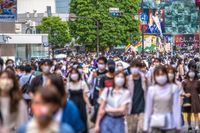Spring is a season that brings warmer weather, blooming flowers, and, unfortunately, a rise in infectious diseases. This year, health experts are sounding the alarm as numerous outbreaks emerge, particularly affecting vulnerable populations, especially those who are older or have not kept up to date with their vaccinations. As March rolled into April 2025, Japan witnessed alarming reports of infections, particularly with norovirus and measles.
Beginning in March, norovirus cases began skyrocketing across the country. This virus, notorious for causing severe vomiting and diarrhea, resulted in infections in notable clusters. On March 12, a reported 11 individuals met at a yakiniku restaurant in Hokkaido were infected, followed closely by another incident where 37 attendees at a Nagoya restaurant were also affected. The surge in norovirus cases coincides with a broader trend of increasing community mobility as restrictions from the previous years have lifted.
Notably, measles cases are also on the rise, with growing concern over outbreaks. On April 4, a woman in her 20s from Yamaguchi Prefecture and her male companion were confirmed as the latest cases, showing that the fast-spreading disease has not diminished. Following that, on April 5, another woman in her 30s from Hyogo Prefecture was reported infected. By April 8, a man in his 40s from Chiba Prefecture and a 0-year-old boy in Saitama Prefecture followed suit, raising alarms about the potential for a significant outbreak. According to experts, the strong connection to travel history—many infected individuals had recently traveled to the Philippines or Vietnam—suggests a wider global context in this outbreak.
The problem extends beyond borders as the United States has also faced a concerning resurgence of measles. Reports have now confirmed over 160 cases in Texas alone, with fatalities occurring for the first time in a decade across multiple states, including California and New York. This situation paints a worrying picture of how interconnected our public health is and raises questions about vaccine coverage and public health policy.
In Japan, while the measles vaccination rate was recorded at 92% nationwide by the end of March 2024, the National Institute of Infectious Diseases has set a higher target of at least 95% to ensure herd immunity. Despite this relatively high rate, there remains a significant portion of the population born before 1972 who may not have received adequate vaccination. “As many as 30% may not receive their complete doses due to historical vaccination policies that were less rigorous,” stated health expert Masahiro Ue. This could lead to critical vulnerabilities in community immunity.
Measles is particularly contagious, boasting an infection rate nine times higher than influenza. A single case can potentially infect 12 to 18 other individuals. “If someone without antibodies is in the same room or train car as an infected person, there is almost a 100% chance of infection,” Ue continued, emphasizing the ease with which the virus spreads in crowded spaces.
Health organizations have also noted that the complications arising from measles infections are quite severe, with approximately 30% of infected individuals experiencing complications such as pneumonia, which can be deadly. Children and the elderly are particularly at risk, making it vital for communities to maintain high vaccination rates to avoid outbreaks.
In light of these concerns, Ue also warned that the approaching spring presents additional risks beyond measles and norovirus. Typical springtime changes can weaken people’s immune systems, and with human interactions increasing due to seasonal events, the potential for contracting these diseases rises. Ue stated, “Spring is particularly dangerous due to increased human contact and physiological stresses impacting our immune response.”
Alongside these common illnesses, other disease threats, such as rubella and mumps, also present cautionary tales. Adults are often at risk for diseases that they think are limited to childhood, Ue stressed, with under-50 individuals often forgetting to verify their vaccination statuses. “Many may not realize they haven’t had adequate vaccinations against these diseases,” he advised.
In Japan, general awareness of vaccination status, particularly among adults over 50 years old, is troublingly low. Individuals born prior to 1972 may not have received any vaccinations, while those born between 1972 and 1990 may only have one. Observing vaccination requirements and ensuring accordingly are critical factors in protecting the community from further outbreaks.
Earlier this year, the onset of various viral illnesses that coincide with seasonal changes required an urgent reminder that even those who had childhood vaccinations are encouraged to receive their adult booster shots. With significant numbers of people remaining unvaccinated, or with incomplete vaccination histories, the margin for potential outbreaks continues to loom large.
Public health initiatives are vital, particularly emphasizing booster shots for older individuals who might see a resurgence in dormant diseases as their immunity wanes. Through societal awareness, we can aim to bolster community health and ensure a safer spring for everyone.
With the onset of the annual cherry blossom viewing, public gatherings will inevitably increase as people celebrate, further increasing interaction rates. Ue flagged the propensity for increased contact to facilitate the spread of infection in these joyous atmospheres. “Community events like hanami can inadvertently lead to higher infection rates if vigilance is not maintained,” he warned.
As this spring unfolds, health officials urge cooperation, vaccination, and vigilance to mitigate the risks faced by the population. We must remain proactive in ensuring that we protect the most vulnerable as we navigate this season of warmth and renewal.


